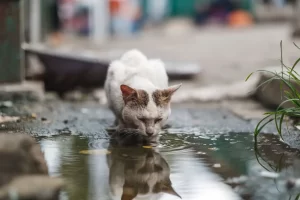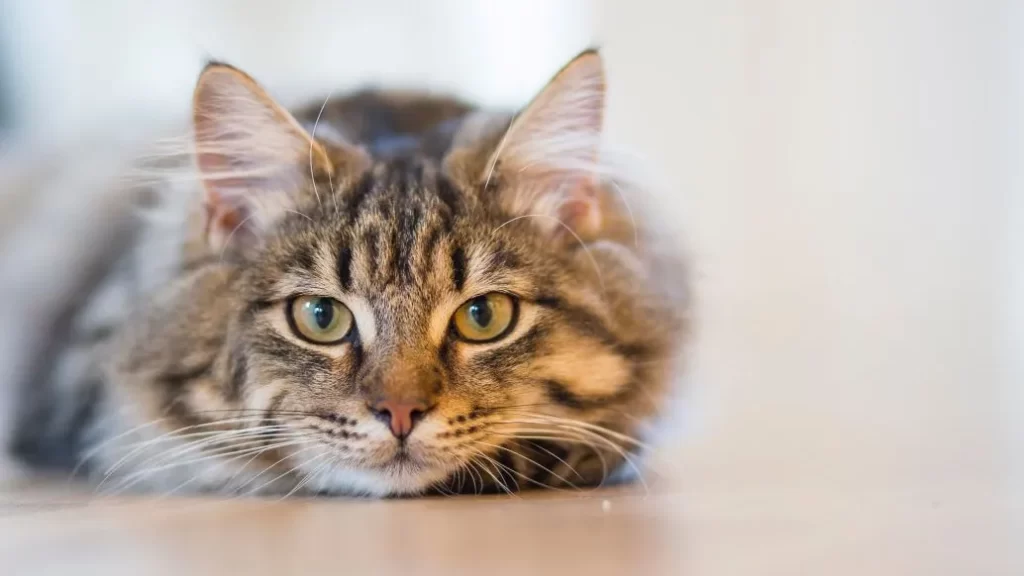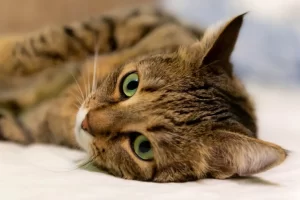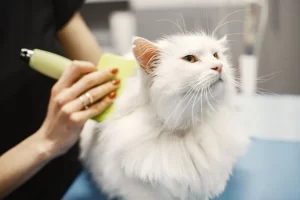Blood in a cat’s stool can indicate a variety of underlying health issues, from minor irritation to more serious conditions. However, there are a number of simple home remedies that can help to alleviate symptoms and provide relief for your furry friend. In this article, we will explore the causes of blood in cat stool, as well as the various home remedies that can be used to address this issue. From dietary changes to herbal supplements, we will cover everything you need to know to help your cat feel better and prevent further complications.
Table of Contents
ToggleCauses of blood in cat stool
According to PetMed, Causes of blood in cat stool can be divided into two main categories: those that affect the lower intestinal tract (colon and rectum) and those that affect the upper intestinal tract (small intestine and stomach).
Lower intestinal tract causes:
- Colitis: Inflammation of the colon, which can be caused by a variety of factors including infection, stress, dietary changes, and certain medications.
- Hemorrhagic Gastroenteritis: Inflammation and bleeding of the stomach and intestines, which can be caused by a variety of factors including bacterial or viral infections, toxins, and stress.
Upper intestinal tract causes:
- Inflammatory Bowel Disease (IBD): A chronic condition characterized by inflammation of the intestinal tract, which can be caused by a variety of factors including genetics, infection, and immune system dysfunction.
- Gastritis: Inflammation of the stomach lining, which can be caused by a variety of factors including infection, stress, dietary changes, and certain medications.
Other causes:
- Cancer: Tumors or cancerous growth in the intestinal tract can cause blood in the stool (learn more about cat cancers and associated home treatments).
- Parasites: Internal parasites such as worms can cause blood in the stool.
- Foreign bodies: Cats may ingest foreign objects such as small toys or string which can cause bleeding in the intestinal tract.
- Blood clotting disorders: Certain blood clotting disorders can cause blood in the stool.
It is important to note that there are many other possible causes of blood in cat stool, and it is important to consult with a veterinarian to determine the underlying cause and develop an appropriate treatment plan.
Related article: How often do you take a cat to the vet?
Categories of home remedies for blood in cat stool
There are several main categories of home remedies that can be used in cats with blood in their stool:
- Diet and nutritional changes: This includes switching to a hypoallergenic or limited ingredient diet, adding fiber to the diet, and supplementing with probiotics and prebiotics to support gut health.
- Herbal supplements: Certain herbs, such as slippery elm, marshmallow root, and aloe vera, can help to soothe an irritated intestinal lining and promote healing.
- Over-the-counter medications: Anti-diarrheal and anti-inflammatory drugs can help to alleviate symptoms, but should only be used under the guidance of a veterinarian.
- Stress management: Addressing environmental stressors, such as the lack of hiding spots or scratching posts, can help to alleviate symptoms and prevent exacerbation of the condition.
- Hydration: Maintaining proper hydration is important for overall health and can help to alleviate symptoms of blood in the stool.
- Regular monitoring and veterinary check-ups: Keeping track of symptoms and consulting with a veterinarian regularly is important to catch and address any underlying health issues, and to ensure that the cat is responding well to any treatment.
It’s important to remember that each cat is unique and might need different treatment, so consulting with a veterinarian is crucial before applying any home remedies, to ensure that the treatment is safe and appropriate for your cat’s specific condition.
Managing blood in cat stool through diet and nutrition
Diet and nutritional changes can play an important role in managing blood in a cat’s stool. Some of the potential benefits of switching to a hypoallergenic or limited-ingredient diet include:
- Reducing inflammation: Certain ingredients, such as grains and certain proteins, can cause inflammation in the intestinal tract. By switching to a diet that eliminates or limits these ingredients, inflammation can be reduced, which can help to alleviate symptoms of blood in the stool.
- Identifying food allergies: Food allergies or sensitivities can cause inflammation and bleeding in the intestinal tract. By switching to a hypoallergenic or limited-ingredient diet, it can be easier to identify the specific ingredient(s) that are causing the problem and eliminate them from the diet.
- Improving gut health: A diet that is high in fiber and contains probiotics and prebiotics can help to improve gut health, which can promote healing and alleviate symptoms of blood in the stool.
- Reducing the risk of recurrence: By identifying and eliminating the specific cause of the blood in the stool, the risk of recurrence can be reduced.
It’s important to note that dietary changes should be made gradually and under the guidance of a veterinarian to ensure that the cat is getting all the necessary nutrients. Also, switching to a new diet can take some time, and it’s important to monitor the cat’s stools closely to ensure that the symptoms are improving. In some cases, the cat might need a special diet that is formulated to address the specific underlying cause of the blood in the stool.
There are several diets that may be beneficial for cats with blood in their stool, but it is important to consult with a veterinarian before making any changes to your cat’s diet. Some diets that may be beneficial include:
- Hypoallergenic diets: These diets are designed to eliminate common allergens, such as beef, chicken, and dairy, and are often made with novel protein sources, such as fish, rabbit, or venison, that the cat may not have been exposed to before.
- Limited ingredient diets: These diets have a limited number of ingredients and are designed to be easily digestible and less likely to cause an adverse reaction.
- Prescription diets: Some veterinary diets are formulated specifically to address certain medical conditions, such as inflammatory bowel disease or food allergies.
- Homemade diets: Preparing a homemade diet under the guidance of a veterinarian can allow you to control the ingredients and ensure that the cat is getting all the necessary nutrients.
It’s important to note that dietary changes should be made gradually and under the guidance of a veterinarian to ensure that the cat is getting all the necessary nutrients. Also, switching to a new diet can take some time, and it’s important to monitor the cat’s stools closely to ensure that the symptoms are improving.
Fiber-rich diet for managing blood in cat stool
Adding fiber to a cat’s diet can have several benefits for cats with blood in their stool. Some of the benefits of adding fiber include:
- Promoting regular bowel movements: Fiber can help to bulk up stools and promote regular bowel movements, which can help to alleviate symptoms of constipation or diarrhea.
- Soothing the intestinal lining: Certain types of fibers, such as psyllium husk and slippery elm powder, can help to soothe the intestinal lining and promote healing.
- Supporting gut health: Fiber can help to feed beneficial bacteria in the gut, which can help to support overall gut health and improve the function of the immune system.
- Reducing inflammation: Some types of fibers have been shown to have anti-inflammatory properties, which can help to reduce inflammation in the intestinal tract and alleviate symptoms of blood in the stool.
Examples of foods that can be added to a cat’s diet for fiber include:
- Pumpkin: Pumpkin is a great source of dietary fiber, and it also contains beneficial vitamins and minerals such as vitamins A, C, and E, potassium, and iron.
- Berries: Berries such as blueberries and raspberries are rich in antioxidants and fiber, which can help to support gut health and reduce inflammation.
- Oat bran: Oat bran is a great source of soluble fiber, which can help to promote regular bowel movements and soothe the intestinal lining.
- Sweet potatoes: Sweet potatoes are a great source of dietary fiber, and they also contain beneficial vitamins and minerals such as vitamins A, C, and E, potassium, and iron.
It is important to note that cats have a different intestinal tract compared to dogs or humans and might not tolerate a high-fiber diet, so it’s important to consult with a veterinarian before adding fiber to a cat’s diet and to start with small amounts and gradually increasing it. Also, it’s important to use a high-quality fiber supplement that is appropriate for cats and to monitor the cat’s stools closely to ensure that the symptoms are improving.
Herbal supplements for treating blood in the stool of cats
Herbal supplements can be a useful addition to a cat’s diet when dealing with blood in the stool. Some of the commonly used herbal supplements include:
- Slippery elm: Slippery elm is a herb that is rich in mucilage, a type of fiber that can help to soothe the intestinal lining and promote healing. This can be beneficial for cats with irritable bowel disease or colitis.
- Marshmallow root: Marshmallow root is another herb that is rich in mucilage, and it can help to soothe the intestinal lining and reduce inflammation.
- Aloe vera: Aloe vera is a succulent plant that is known for its anti-inflammatory and healing properties. It contains compounds called mucopolysaccharides that can help to soothe the intestinal lining and promote healing.
- Turmeric: Turmeric contains a compound called curcumin, which has anti-inflammatory properties. It can help to reduce inflammation in the intestinal tract and alleviate symptoms of blood in the stool.
- Licorice root: Licorice root has anti-inflammatory and soothing properties, which may be helpful for cats with inflammatory bowel disease or colitis.
- Ginger: Ginger has anti-inflammatory properties and can help to reduce inflammation in the intestinal tract, which may be beneficial for cats with blood in their stool.
- Chamomile: Chamomile has anti-inflammatory and soothing properties and can help to reduce inflammation in the intestinal tract and alleviate symptoms of blood in the stool.
Herbal supplements for cats with blood in their stool can be administered in a variety of ways, depending on the supplement and the cat’s individual needs. Some common methods of administration include:
- Oral supplements: Many herbal supplements come in the form of capsules, tablets, or powders that can be mixed with food or water. This is an easy and convenient way to administer the supplement, but it’s important to make sure the cat is consuming the entire dose.
- Topical application: Some herbal supplements, such as aloe vera, can be applied topically to the affected area. For example, aloe vera gel can be applied to the anus to soothe irritated skin and promote healing.
- Tinctures: Tinctures are liquid extracts of herbs that can be added to food or water. Tinctures are more potent than other forms of herbal supplements and are easy to administer.
- Tea infusion: Some herbs can be made into a tea infusion and given orally to the cat. It’s important to make sure the tea is cooled before giving it to the cat.
These supplements should be used under the guidance of a veterinarian, as some of them might interact with other medications the cat is taking. It’s important to use a high-quality supplement that is appropriate for cats and to monitor the cat’s stools closely to ensure that the symptoms are improving.
Managing blood in cat stool with OTC medications
Over-the-counter medications such as anti-diarrheal and anti-inflammatory drugs can be used to manage blood in cat stool, but it is important to use them under the guidance of a veterinarian. Some examples of over-the-counter medications that may be used to treat blood in cat stool include:
- Anti-diarrheal medication: An example of this medication can be Loperamide (Imodium) which can be used to reduce diarrhea and control the symptoms of blood in the stool.
- Anti-inflammatory medication: An example of this medication can be Metamizole (Novalgin) which can help to reduce inflammation in the intestinal tract and alleviate symptoms of blood in the stool.
- Anti-spasmodic medication: An example of this medication can be Hyoscyamine (Levsin) can help to relax the smooth muscles in the intestinal tract and alleviate cramping and spasms, which can be helpful for cats with blood in their stool.
It’s important to note that these medications should be used under the guidance of a veterinarian, as some of them might interact with other medications the cat is taking. It’s important to use a high-quality medication that is appropriate for cats and to monitor the cat’s stools closely to ensure that the symptoms are improving.
Reducing stress in cats to manage blood in stool
Stress can play a significant role in exacerbating symptoms of blood in cat stool, as it can disrupt the normal functioning of the intestinal tract and lead to inflammation. To help manage stress, and potentially alleviate symptoms of blood in cat stool, it can be beneficial to provide environmental enrichment for cats. Environmental enrichment refers to creating a living environment that is stimulating and satisfying for the cat and can include things such as:
- Providing hiding spots: Cats are natural predators and need a place to hide in order to feel safe. Providing hiding spots such as boxes, tents, or cat trees can give cats a sense of security and reduce stress.
- Providing scratching posts: Scratching is a natural behavior for cats, and providing scratching posts can give cats an outlet for this behavior and reduce stress.
- Providing interactive toys: Toys that encourage cats to hunt and play can be stimulating and satisfying for cats and can reduce stress.
- Providing a window perch: Cats are natural observers and providing a window perch can give them a place to watch the outside world, which can be calming and reduce stress.
- Providing a companion: Cats are social animals and providing a companion can give them companionship and reduce stress.
It’s important to note that these environmental enrichment strategies should be used in conjunction with veterinary care, and any cat with blood in their stool should be evaluated by a veterinarian to determine the underlying cause of the bleeding and to develop an appropriate treatment plan. Additionally, not all cats will react the same way to these strategies, so it’s important to observe the cat’s behavior and see what works best for them.

Hydration is critical for cats with blood in stool
Ensuring that cats remain properly hydrated is of paramount importance for their overall well-being, especially when they exhibit symptoms such as blood in their stool. Dehydration in cats can lead to dry and irritated intestinal tracts, which can exacerbate issues related to bloody stool. Moreover, adequate hydration is vital for the optimal function of their kidneys and liver, which play a critical role in filtering toxins from the blood and eliminating them via urine.
To effectively maintain a cat’s hydration, it’s imperative to provide them with a consistent supply of clean and fresh water. This can be achieved by routinely replenishing their water bowl or opting for a water fountain, which some cats find more enticing due to the flowing water. Monitoring a cat’s water intake and encouraging additional consumption if it’s insufficient is equally essential.
Alongside a readily available water source, a diet rich in moisture is beneficial. Wet food serves as an excellent means of hydration and can be offered either in conjunction with or in place of dry food. A high-moisture diet also aids in preventing constipation, which may contribute to the occurrence of blood in the stool.
However, it’s crucial to understand that hydration is merely one component of a cat’s overall health. It should be considered alongside other factors such as diet, exercise, stress levels, and regular veterinary care. When a cat experiences blood in their stool, it is highly recommended to consult with a veterinarian who can determine the root cause of the bleeding and formulate an appropriate treatment plan.
The uses of probiotics and prebiotics to support gut health and promote healing
Probiotics and prebiotics can be a great addition to the management of blood in a cat’s stool as they support gut health and promote healing. Probiotics are live microorganisms that are similar to the beneficial microorganisms found in the gut and can help balance the gut microbiome. Prebiotics, on the other hand, are non-digestible fibers that help nourish and support the growth of beneficial bacteria.
Some examples of probiotics that may be beneficial for cats with blood in their stool include Lactobacillus acidophilus and Bifidobacterium bifidum. Prebiotics such as fructooligosaccharides (FOS) and inulin can also be helpful. These supplements can be added to the cat’s diet or given as a separate supplement under the guidance of a veterinarian. However, it’s important to note that probiotics and prebiotics should not be used as a replacement for veterinary care, they should be used in conjunction with other treatments and as a part of a comprehensive treatment plan.
When to see a Vet?
It’s important to monitor your cat’s symptoms and overall health closely, especially if they have blood in their stool. If you notice that your cat’s symptoms are not improving or getting worse despite treatment, it may be necessary to seek veterinary care. Signs that may indicate a need for veterinary care include:
- Persistent or severe diarrhea
- Persistent or severe vomiting
- Blood in the stool that is not improving or getting worse
- Loss of appetite or weight loss
- Lethargy or weakness
- Abdominal pain or swelling
- Dehydration, as indicated by dry gums, sunken eyes, or a decrease in skin elasticity.
If you notice any of these signs, it’s best to contact your veterinarian immediately for guidance on how to proceed with your cat’s treatment. They may need to perform additional diagnostic tests or adjust the treatment plan to ensure your cat’s condition improves.
Preventing blood in a cat’s stool
Preventing blood in a cat’s stool can be accomplished by following these methods:
- Providing a healthy diet: Feeding your cat a nutritionally balanced diet can help prevent blood in the stool. This may involve switching to a hypoallergenic or limited ingredient diet, or adding fiber to the diet, such as through the use of psyllium husk or slippery elm powder.
- Maintaining a healthy weight: Obesity can increase the risk of blood in the stool, therefore, keeping your cat at a healthy weight can help prevent this condition.
- Regular veterinary check-ups: Regular veterinary check-ups can help detect underlying health conditions that may cause blood in the stool.
- Parasite control: Regularly deworming your cat at home can help prevent parasites that can cause blood in the stool.
- Environmental enrichment: Providing hiding spots, scratching posts, and other forms of environmental enrichment can help reduce stress and anxiety in cats, which can exacerbate symptoms of blood in the stool.
- Proper hygiene: Keeping your cat’s living area clean and hygienic can help prevent blood in the stool caused by infections.
- Avoiding exposure to toxins: Keep your cat away from chemicals, pesticides, and other toxins that can cause blood in the stool.
- Proper use of medications: Before giving any medication or supplement, it’s important to read the label and consult with a veterinarian to ensure that it is safe for your cat.














